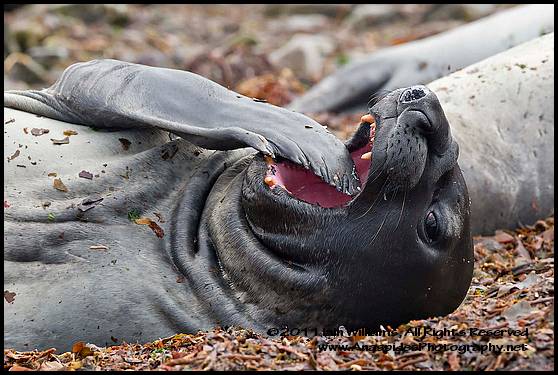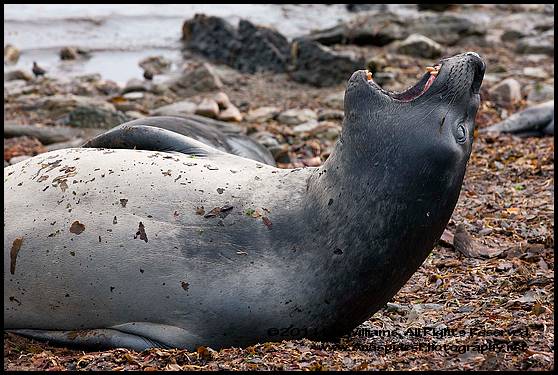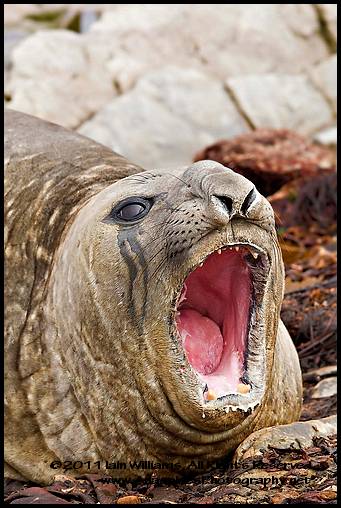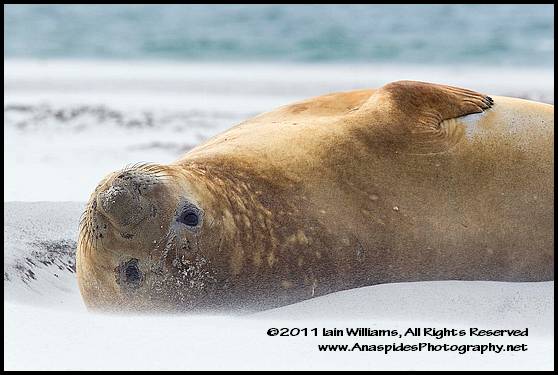Southern Elephant Seals, Falkland Islands - 2nd Post
 Thursday, March 24, 2011 at 10:02AM
Thursday, March 24, 2011 at 10:02AM  This is my second post regarding my trip to the Falklands. To read the earlier post navigate here.
This is my second post regarding my trip to the Falklands. To read the earlier post navigate here.
LEFT: Young female Southern Elephant Seal plays with her flipper as she watches photographer.
Southern Elephant Seals (Mirounga leomina) are the largest of the seals, with a marked difference in size between the male, growing up 3700 kg (5-7 metres long), and the female, growing 500-800 kg (2-4 metres long). The male has a distinctive proboscis that is fully developed by the eighth or ninth year. The male’s nose, when inflated, acts as a resonating chamber to produce a deafening roar.
 Elephant Seals are found throughout the Southern Ocean, although the seals from the South Atlantic stock do not freely mix and breed with those from Macquarie Island, the New Zealand subantarctic islands or the islands in the South Indian Ocean. A renown diver, elephant seals have been known to dives to depths between 400 and 600 meters for a duration between 20-30 minutes in their pursuit of fish, octopus and squid.
Elephant Seals are found throughout the Southern Ocean, although the seals from the South Atlantic stock do not freely mix and breed with those from Macquarie Island, the New Zealand subantarctic islands or the islands in the South Indian Ocean. A renown diver, elephant seals have been known to dives to depths between 400 and 600 meters for a duration between 20-30 minutes in their pursuit of fish, octopus and squid.
Click here to read about their Northern Hemisphere close cousin the Northern Elephant Seal.
LEFT: A young female Southern Elephant Seal rolls onto its back and "barks".
Multiple Insemination
 Elephant seal males reach sexual maturity at around 10 years of age and preside over a harem of 1 to 30 females. There are more male elephant seals than females and not every male will breed; only the very best fighters and defenders of their harem will pass along their genes to the next generation. The dominant male is called a “Beach Master” or “Lead Seal” and his task is very simple – to breed as many times as possible with the females in his harem. A successful male will inseminate up to 100 cows (female seals) in a season. When not breeding, he is fighting off rival males which continuously swim along the shoreline seeking a break into his defence line and replace him.
Elephant seal males reach sexual maturity at around 10 years of age and preside over a harem of 1 to 30 females. There are more male elephant seals than females and not every male will breed; only the very best fighters and defenders of their harem will pass along their genes to the next generation. The dominant male is called a “Beach Master” or “Lead Seal” and his task is very simple – to breed as many times as possible with the females in his harem. A successful male will inseminate up to 100 cows (female seals) in a season. When not breeding, he is fighting off rival males which continuously swim along the shoreline seeking a break into his defence line and replace him.
Fighting Rivals
Fighting between males can be a noisy and bloody affair with the lesser male usually retreating before sustaining permanent or debilitating injuries. However, this is not always the case and if a Lead Seal is beaten by a stronger rival, injuries are apparent from torn noses and puncture marks to disgorged eyes. Whilst the fighting occurs, females and new-born young scurry to keep out of the way and it’s not uncommon to observe young pups being crushed as males fight each other, oblivious to their surroundings. It’s difficulty to translate the immense strength that these animals convey as they hurl themselves at each other.
Life as a Cow is not Pleasant
Life as a cow is not overly pleasant. In October, pregnant cows haul out onto beaches and rocky foreshores, plump from feeding at sea. A male will often include the cow in his harem and then spend the next few months mating or attempting to mate with her along with other cows (before or after birth). Once a  cow has given birth, it will feed its pup a very rich high protein milk designed to put as much blubber onto the youngster as possible. Once the calves are weaned, the mother seal will return to the ocean to feed before returning in January to moult. Moulting can take several weeks and during this time the skin of the seal peels off similar to a bad case of sunburn. Males moult about a month after females.
cow has given birth, it will feed its pup a very rich high protein milk designed to put as much blubber onto the youngster as possible. Once the calves are weaned, the mother seal will return to the ocean to feed before returning in January to moult. Moulting can take several weeks and during this time the skin of the seal peels off similar to a bad case of sunburn. Males moult about a month after females.
LEFT: Elephant seals do not form family units, but often lie together for warmth or protection from the environment.
Photographing the Elephant Seals
Photographing the elephant seals can be challenging. For the most part the seals are not aggressive and if you maintain a reasonable distance they ignore you. But, if you venture too close you are liable to be charged by a Lead Seal, or be exposed to a large jaw filled with long canine-like sharp teeth, to warn you of your incursion.
For the most part, unless working in very low light or at the outskirts of a colony, I don’t use a tripod when photographing seals. The main reason for this is that setting up a tripod can be costly in time, raises yourself above the ground substantially which maybe taken as an aggressive posture, and limits your freedom of movement. Unless shooting extreme wide angle close ups using a 16-35 f2.8 zoom lens, I use a 70-200 f2.8 zoom lens. The zoom gives the added advantage of being able maintain your position. If further reach is required, a 1.4 tele-converter can be added to the 70-200. The benefits of the shorter lens and no tripod translate to being able to turn and manoeuvre much more quickly than with a tripod; often this is the difference between getting a shot and missing it. Further, if you are charged, you can retreat much more quickly without carrying a tripod.
 LEFT: Female Southern Elephant Seal rests on beach seemingly ambivalent to the 40 knot wind and entrained sand.
LEFT: Female Southern Elephant Seal rests on beach seemingly ambivalent to the 40 knot wind and entrained sand.
The seals stay on the beach no matter what the environmental conditions. I observed a small group of cows lying beside each other in chilly 40 knot winds! They raised their heads long enough to see that I wasn’t a threat – or a male Lead Seal.
Shooting in these conditions can be very problematic. The strong winds make using a tripod difficult due to vibration, and the entrained sand in the wind continually sandblasts your equipment. In conditions such as this it’s imperative that you pre-visualise your image before actually shooting it; It isn’t possible t o change a lens for a different focal point, unless you want a sensor and lens full of sand. Furthermore, a cover such as storm cover is highly advised to minimise the amount of sand that finds its way into every recess in your lens and camera.
o change a lens for a different focal point, unless you want a sensor and lens full of sand. Furthermore, a cover such as storm cover is highly advised to minimise the amount of sand that finds its way into every recess in your lens and camera.
I like elephant seals, and what's not to like. Their large sad-looking eyes just attract you and it's difficult to remember that these are wild animals without any emotive interest in you wbatsoever. I can spend hours lying beside them, watching and listening as they go about their daily routine. The longer you spend with an individual or group, the more relaxed they become, and although your not a seal (I hope not a female), you do feel accepted as an honorary member of the harem.
Click here to see more images of elephant seals and other seal species
Click here to read more about the southern Elephant Seal.
In my next post we’ll look at some of the penguins that call the Falklands home.



Reader Comments (5)
I have been following your blog on and off since it began. The photographs are excellent and the text informative. I especially like the way you discuss the animals and the environment without undue self advertisement. I find that today many blogs talk only about the writer and how good they are. Your Blog is an exception. Thank you for the taking the time and effort to share your images and experiences. Keith Payne
Tasmanian devils to elephant seals - wow. I just love the way the seal is nibbling at her flipper. Great shot at just the right time, Michy
Terrific shots, Iain! There's just something so fun about elephant seals. I really like the last one with the eye contact through the blowing sand!
Thanks Pat. I enjoy spending time with elephant seals - they are always fun
Hi Mich & Keith - Yes the finger nail biting was interesting Michelle & thank you for your kind words Keith; I'm glad you find the information interesting. Best, Iain
Cute